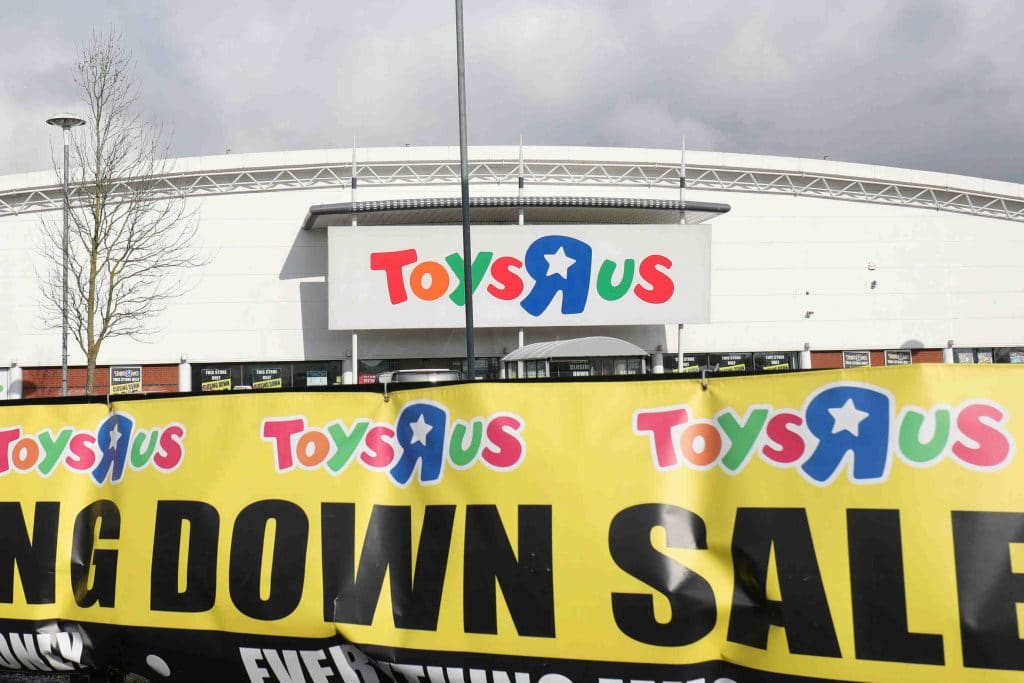December 4, 2017: Toys R Us UK files for a company voluntary agreement (CVA), proposing the closure 26 loss making stores.
This followed the announcement in October that many UK suppliers had stopped shipments to Toys R Us over fears troubles at its owner in the US could see the company collapse before they were paid. December’s CVA compounded concerns that troubles were not contained in the US.
Much like September’s “Project Sunrise”, a somewhat unconvincing plan to restructure the US arm after filing for bankruptcy, the CVA sought to “reposition its real estate portfolio for future growth and profitability”.
“Toys R Us’ large warehouse stores were once exciting as children had never been able to see such a wide range of toys in one place but online shopping now offers a more convenient way to browse such a wide selection of toys,” Globaldata’s Fiona Paton said at the time.
“Toys R Us has not completely neglected online and currently offers free delivery over £29.99 and free click & collect in 29 minutes. However, Amazon and Argos offer faster, more convenient and affordable delivery options.”
December 5, 2017: Work and Pensions Committee chairman Frank Field writes a letter to the embattled toy retailer.
This is where fundamental and historic cracks began to show. Major missteps by the retailer’s management dating back years began to show, exposing the situation as far worse than previously thought.
The letter referred to a £584.5 million sum in loans that the retailer was owed, which it decided to waive in January despite making a loss of £673.3 million that year.
It also questioned why a full actuarial valuation, which is used to determine potential future liabilities, had not been carried out since 2007.
More worryingly it highlighted Toys R Us’ £18.4 million pensions deficit, which had nearly doubled from £10.3 million a year prior.
December 11, 2017: Further governance missteps are revealed while its CVA is threatened by the Pension Protection Fund (PPF).
News that UK boss Roger Mclaughlan was paid £1.3 million in 2016, nearly three times the amount paid just two years earlier trampled whatever reputation Toys R Us’ management had left. This was emphasised by news that £10 million in bonuses were paid out in its US arm despite the bankruptcy filing.
Having hit the headlines over Christmas, these revelations suggested deeply ingrained problems at Toys R Us, piling drawbacks on for any potential buyers of which the it was still confident in securing.
Elsewhere the retailer’s pension deficit in the UK started to cause it more problems. The PPF, which would act as its biggest creditor should it collapse, expressed concern over the proposed CVA.
Though for Toys R Us this was its last chance to avoid complete collapse, the PPF questioned whether this was “simply kicking the can down the road”, revealing just how weak confidence in the retailer had gotten.
December 19, 2017: The PPF says it will vote against the CVA unless Toys R Us agrees to pay £9.8 million a year into its pensions deficit.
Just days ahead of the shareholder vote on whether to pass the CVA the pensions lifeboat, which held a decisive 20 per cent of the vote, said it wanted to “ensure the pension scheme would not be weakened by the CVA, leading to an even bigger claim on the PPF and its levy payers further down the line.”
December 21, 2017: Toys R Us agrees to the PPF’s demands preventing collapse just days before Christmas.
The proposed store closures were now set to go ahead and there was some hope that the CVA could effectively rescue the company from complete collapse.
February 1, 2018: Alvarez & Marshal, the company dealing with the US retailer’s bankruptcy protection, begins the search for a potential buyer.
This is the start of the very last leg of Toys R Us’ collapse into administration. It remained confident a buyer would be found within a few weeks, despite its severe problems being laid bare over before the new year.
Its UK arm was once again plunged into uncertainty, as it was unknown whether a new buyer would commit to the £9.8 million pensions bill agreed with the PPF.
READ MORE:
February 12, 2018: The scramble to find a buyer becomes more desperate as deadlines emerge for substantial sums to be paid.
The retailer revealed that an immediate £50 million cash injection was required before the end of the month as debt payment deadlines drew worryingly close. Sources also speculated that a further £70 million would be required to fund a turnaround scheme in its first year.
There was some hope as Hilco Capital, the firm responsible for saving HMV from bankruptcy, had expressed interest.
This was perhaps the first time Toys R Us’ major debt piles started jeopardising its chances of survival, after more than 10 years of restructuring and paying hundreds of millions in interest.
Without the pressing deadlines posed by debt obligations or the substantial upfront cost it is likely Toys R Us would have found a buyer.
February 16, 2018: A £15 million VAT tax bill slashes the deadline to just a few days as new potential buyers emerge.
Toys R Us announces it will work through the weekend in an effort to progress talks with potential bidders, which now included Alteri Investors and its main rival The Entertainer.
February 23, 2018: Store closures continue across the pond as its US arm attempts to reassure investors it can restructure to survive.
Plans to shut another 200 US stores were revealed, after it pulled the shutters on 182 loss making stores throughout January slashing 4500 jobs.
Though hope remained for both UK and US operations, the reality of the potential to fall into liquidation was setting in. Whatever buyout deal could have been agreed, it was becoming increasingly clear that severe reductions in staff and stores were inevitable.
February 26, 2018: Buyers walk away from the deal last minute as hopes fade.
Talk of administrators taking control of the company as early as a day later began to spread, as it was confirmed both Hilco Capital and Alteri Investors abandoned talks at the 11th hour.
With the £15 million VAT tax deadline due in a matter of hours, Toys R Us UK’s fate was all but sealed.
February 28, 2018: Administrators are appointed to begin deconstructing the retailer, placing over 3000 jobs at risk.
Moorfields is brought in to handle the process, stating: “We will be conducting an orderly wind-down of the store portfolio over the coming weeks.
“All stores remain open until further notice and stock will be subject to clearance and special promotions. We’re encouraging customers to redeem their gift cards and vouchers as soon as possible.
“We will make every effort to secure a buyer for all or part of the business.”
In its wake it left a £37 million pensions deficit, leaving the Pensions Protection Fund (PPF) to absorb the costs to avoid thousands of staff pensions being affected.
March 14, 2018: Toys R Us’ US arm follows suit and collapses, leaving 30,000 staff at risk across 885 stores.
Though it was already in the process of shutting 20 per cent of its estate, it was similarly hit by debt deadlines after failing to find any investors to take on the mammoth task of turning its fortunes around.
“This is a profoundly sad day for us as well as the millions of kids and families who we have served for the past 70 years,” Toys R Us chief executive Dave Brandon said.
Click here to sign up to Retail Gazette‘s free daily email newsletter


















